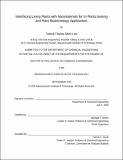Interfacing living plants with nanomaterials for in planta sensing and plant biotechnology applications
Author(s)
Salim Lew, Tedrick Thomas.
Download1351471530-MIT.pdf (7.725Mb)
Other Contributors
Massachusetts Institute of Technology. Department of Chemical Engineering.
Advisor
Michael S. Strano.
Terms of use
Metadata
Show full item recordAbstract
Plants represent an important biological system which can self-repair, grow autonomously and generate energy from sunlight and photosynthesis. As sessile organisms, they have evolved complex internal and inter-organism signaling pathways with distinct structures to thrive in ever-changing and at times unpredictable conditions. While humans have used plants as a source of food and raw materials for millenia, we have only considered living plants as a technology in recent years. A major advance in this area is the emergence of plant nanobionics, a field which interfaces living plants with nanotechnology to impart the former with novel and non-native functionalities. The broad vision of plant nanobionics is to use rationally-designed nanoparticles to engineer a wide array of plant-based technologies, not genetically limited to specific plant species, to potentially replace the myriad devices in our everyday lives stamped out of plastic, containing circuit boards and consuming power from the electrical grid. Nanomaterials are ideal candidates for interfacing with plants due to their unique physical and electronic properties, which can be rationally modified to complement and augment the biological properties of living plants. In addition, engineered nanomaterials can serve as nanocarriers to deliver biomolecular cargo, as well as nanosensors to translate the invisible plant internal signaling into an optical readout easily interpreted by portable electronics. This thesis investigates the underlying mechanisms of interaction between nanoparticles and plant membranes, and explores the diverse plant biotechnology and agricultural applications enabled by interfacing living plants with nanomaterials. We first study the influence of nanoparticle physical properties on their ability to traffic into plant cells and organelles. We show that the uptake and localization of nanoparticles in plant cells is governed mainly by their surface charge and size. An experimentally-verified thermodynamic model, termed Lipid Exchange Envelope Penetration (LEEP), was formulated to guide the rational design of nanoparticles to target specific subcellular compartments within the plant cell. Leveraging on these design principles, we synthesize a new class of single-walled carbon nanotube (SWNT)-based nanocarriers to selectively deliver plasmid DNA into the chloroplasts of mature living plants. The nanoparticle-mediated delivery platform can protect and safely deliver genes into the chloroplasts of both model and agriculturally-relevant crops without mechanical aid. The nanocarrier approach enables strong transient expression of reporter proteins in Arabidopsis thaliana, wild-type watercress (Nasturtium officinale), spinach (Spinacia oleracea) and tobacco (Nicotiana benthamiana) plants. We further design another class of SWNT nanocarriers to deliver genes into pollen grains, the male gametophyte of flowering plants. The difficulty of delivering exogenous DNA into pollen grains, due to chemically inert cell walls, has hindered their wide application in agricultural biotechnology. Utilizing the LEEP model, we engineer imidazolium-functionalized SWNTs to efficiently traffic past the pollen membranes. These findings provide insights for the rational design and refinement of nanocarriers for plant biotechnology applications. This thesis also explores the application of nanomaterials as optical nanosensors to study the plant defense signaling pathways. In this study, we employ near-infrared fluorescent SWNT nanosensors developed using the Corona Phase Molecular Recognition (CoPhMoRe) concept to modulate nanoparticle-analyte binding. The nanosensor platform can capture the fast dynamics of wound-induced H₂O₂ signal propagation in real time non-destructively, enabling interfacing of plant defense network to portable electronics at a standoff distance. We find that the H₂O₂ concentration profile post-wounding follows a logistic waveform for six plant species: lettuce (Lactuca sativa), arugula (Eruca sativa), spinach (Spinacia oleracea), strawberry blite (Blitum capitatum), sorrel (Rumex acetosa), and Arabidopsis thaliana, ranked in order of wave speed from 0.44 to 3.10 cm/min. Our findings highlight the utility of a new type of nanosensor probe that is species-independent and capable of real-time, spatial and temporal biochemical measurements in plants. Lastly, we demonstrate the development of a plant nanobionic sensor for selective and sensitive detection of arsenic in the belowground environment. These optical nanosensors were embedded in plant tissues to monitor the internal dynamics of arsenic taken up by the plants via the roots. A rational design of SWNT nanosensors with high selectivity and intensity modulation towards arsenite is discussed. We exploit the natural ability of an arsenic-hyperaccumulating fern to engineer a nanobionic sensor capable of detecting down to 0.2 ppb level of arsenic, well below the regulatory limit in drinking and irrigation water. These demonstrations highlight the potential of nanomaterials for the creation of future plant nanobionic devices, as well as for the development of species-independent tools for agricultural biotechnology applications.
Description
Thesis: Ph. D., Massachusetts Institute of Technology, Department of Chemical Engineering, September, 2020 Cataloged from the official PDF of thesis. Includes bibliographical references.
Date issued
2020Department
Massachusetts Institute of Technology. Department of Chemical EngineeringPublisher
Massachusetts Institute of Technology
Keywords
Chemical Engineering.